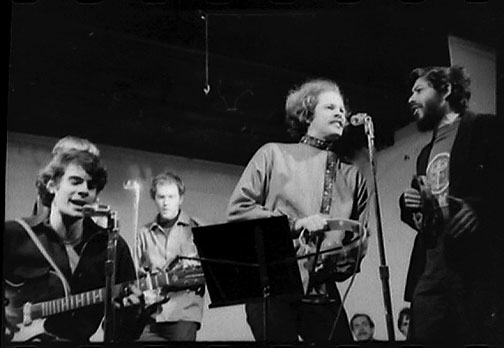We start off today by continuing to look at poets' use of the ballad form, and other song-inflected poetic forms, with Lee Ann Brown. Specifically we'll look at a number of poems from her 2003 book, The Sleep that Changed Everything, including several that also appear in her song cycle, 13th Sunday in Ordinary Time. Links to PennSound MP3s are provided when available, and the readings are here: [PDF]
You should also listen to some of the other tracks from 13th Sunday at your leisure — specifically the suite of Girl Scout songs in the middle — to get a broader sense of the materials from which Brown is drawing in the sequence. You can read my 2008 write-up of the song cycle here.
Next, we'll shift gears a little bit with two projects involving poet and publisher (most famously of the notorious Fuck You / A Magazine of the Arts), Ed Sanders. First, a selection of tracks from the Fugs, the poetry-rock band Sanders and Tuli Kupferberg founded with members of the Holy Modal Rounders (and a variety of other musicians) in 1963, which continues to perform to this day. Their repertoire included both original compositions — which placed an emphasis on political messages and sexual liberation — and settings of classic (and contemporary) poetry:
- Ballad of Amiri B. (60's)
- Ballad of New Orleans
- Ballad of Vertical Integration [MP3]
- Ballad of Phoebe Steele [MP3]
- Ballad of Susan Smith [MP3, followed by "Ballad of Vertical Integration"]
- Red Fox [MP3]
- 3 Rings [MP3]
- Vision Crown [MP3]
 |
| The Fugs play in New York City, 1967. |
"I'm Doin All Right" (with lyrics written by Ted Berrigan)
"Kill for Peace" (can't be embedded, but click through to witness Tuli Kupferberg tormenting New Yorkers)
"Morning, Morning"
"Super Girl" (live, studio version here)
"I Saw the Best Minds of My Generation Rock" (a setting of Allen Ginsberg's "Howl")
"Ah, Sunflower" (a setting of William Blake's poem, which Ginsberg also "covered")
"Dover Beach" (a setting of Matthew Arnold's poem)
In 1992, Sanders conceived of a wide-ranging poetic projecting centered on the hymn "Amazing Grace," written by British poet and clergyman John Newton in 1779. He wrote to many of his poet friends, asking them to contribute their own reworkings of the piece, which is not only a fine example of traditional ballad meter, but also what's known as "Protestant hymn meter" — basically, alternating iambic lines of four and three feet (this is the form that the vast majority of Emily Dickinson's poetry is set in, by the way). The end result is The New Amazing Grace, which was first publicly performed in 1994 in New York City. I'd like you to read Sanders' introduction and the sequence itself — the appendix with letters from the contributors is interesting, but not essential (though feel free to read if you'd like). Here are a two poets performing their contributions to the collection:
Allen Ginsberg's "New Stanzas for 'Amazing Grace'"
Lee Ann Brown, "Three Graces" (includes Brown's "Amazing Grits" and two variations by Bernadette Mayer) [MP3]
Finally, we'll look at a few videos by Jim Carroll, the New York School poet and memoirist (cf. The Basketball Diaries, made into a film in the late 1990s, and its follow-up, Forced Entries), who had a sideline gig leading the punky new wave Jim Carroll band:
"People Who Died" (watch a live version at punk mecca Mabuhay Gardens here; also cf. Ted Berrigan's "People Who Died" [MP3], which inspired Carroll's track)
"Catholic Boy"
Allen Ginsberg's "New Stanzas for 'Amazing Grace'"
Lee Ann Brown, "Three Graces" (includes Brown's "Amazing Grits" and two variations by Bernadette Mayer) [MP3]
Finally, we'll look at a few videos by Jim Carroll, the New York School poet and memoirist (cf. The Basketball Diaries, made into a film in the late 1990s, and its follow-up, Forced Entries), who had a sideline gig leading the punky new wave Jim Carroll band:
"People Who Died" (watch a live version at punk mecca Mabuhay Gardens here; also cf. Ted Berrigan's "People Who Died" [MP3], which inspired Carroll's track)
"Catholic Boy"


No comments:
Post a Comment